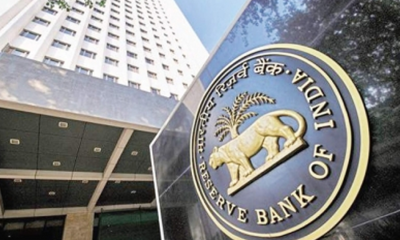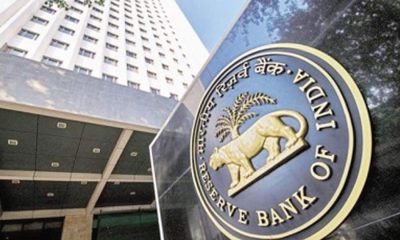Business
Here are some reactions of realtors on RBI’s policy outcome on realty sector

The Reserve Bank of India on Wednesday raised the key lending rate or repo rate by 50 basis points to 4.9 per cent to tame rising inflation, which has been now above the central bank’s 6 per cent tolerance level for four months in a row.
Repo rate is the rate at which the central bank lends short-term funds to banks.
In line with the rate hike by the RBI, some banks and non-banking finance companies too had raised their lending rates, which will essentially lead to an increase in EMIs for borrowers.
On Wednesday, RBI decided to increase the existing limits on individual housing loans by cooperative banks.
Accordingly, the limits for Tier I or Tier II urban cooperative banks shall stand revised from Rs 30 lakh or Rs 70 lakh to Rs 60 lakh or Rs 140 lakh, respectively, which essentially means doubling of the limit.
The increased limits will apply for Primary (Urban) Co-operative Banks (UCBs), and Rural Cooperative Banks (RCBs) — State Cooperative Banks and District Central Cooperative Banks.
For RCBs, the limits will increase from Rs 20 lakh to Rs 50 lakh for such banks with assessed net worth less than Rs 100 crore; and from Rs 30 lakh to Rs 75 lakh for other such RCBs.
Besides, considering the growing need for affordable housing and to realise their potential in providing credit facilities to the housing sector, the RBI decided to allow State Co-operative Banks (StCBs) and District Central Co-operative Banks to extend finance to Commercial Real Estate – Residential Housing (CRE-RH) within the existing aggregate housing finance limit of 5 per cent of their total assets.
Following are some of the reactions from real estate experts and developers on the RBI’s measures:
Rohan Pawar, CEO of Pinnacle Group said, during the pandemic, the low interest rate regime had boosted the housing demand, and RBI’s decision to hike the interest rate again by 50 basis points to 4.90 per cent was expected to tackle the tight inflation of the country.
“The increase of rates could adversely affect housing demand because of increased EMIs and lower eligibility on home loans. This will create an impact on the ongoing growth momentum in the sector in addition to increasing input costs. However, we still believe that preference of homebuyers for owning a home will continue to boost demand.”
Niranjan Hiranandani, Vice Chairman of NAREDCO said, taming steep inflation hike is a preordained measure by RBI, given the global economic ballgame. Soaring commodity prices especially with food and energy prices, plummeting currencies, supply side shocks are the foremost reasons for rising input cost.
“It is evident that home loan interest rate hike will impair the home buying rally as pay out in terms of EMI is scheduled to rise. But according to me this crater in demand sentiment is a makeshift move, as home loans are based on floating rate for a long tenure. The EMI constraint will be eased as rates are expected to normalise once the global situation is stabilised.”
The hike in the limit of individual loans by co-operative banks by 100 per cent is a welcome initiative for home buyers who opt for home loans from co-op banks.
Atul Goel, MD of Goel Ganga Group said, the RBI’s step to increase the repo rate has been on the expected lines. To curb inflation, the regulatory bodies in India were required to control liquidity circulation in the economy. For a few months, the inflation rate has been above 6 per cent, which is beyond the RBI’s safe zone.
“If not controlled, the inflationary pressure could destabilise an otherwise bullish Indian economy. Although the recent step will increase the home loan rates, an unstable economy is not conducive to the overall health of the real estate industry. For the industry to operate optimally, it is important that the economy continues to grow in a stable, inclusive, and steady fashion.”
Suren Goyal, Partner at RPS Group said, the group welcomes the step of the apex body to increase the overall repo rates and believes it will help in clamping down inflation and smoothen economic growth.
“A rise in inflation can soften the stance on an otherwise robust real estate industry. Already raw material prices are increasing and an unbridled rate of inflation will further drive the input costs northwards, therefore resulting in cost overruns for the developer fraternity.”
Manoj Gaur, CMD of Gaurs Group and President- CREDAI NCR said it has been a fine balancing act by RBI.
“We understand that the hike in repo rate by 50 basis points will impact interest rates of consumer loans and make home loan dearer right at the time when real estate sector was coming out of the throes of pandemic and affect sales in the short term. However, by reining in inflation it will ultimately benefit the real estate sector that is bogged down by high input costs.”
Amit Modi, President of CREDAI Western UP opined that the increase in the repo rate will hamper the sentiments of the buyers, especially first time home buyers who are heavily reliant on home loans.
“It will be a barrier to the growth trajectory of the revived sales post-Covid. Millions of homebuyers will be sidelined and alienated from the property markets after the hike. It will slow down the pace of sales that has taken a rise in the recent past.”
Pradeep Aggarwal, Chairman of Signature Global (India) said the repo rate hike could be termed as a reformative move, the stated aim was clear in current macro and micro economic conditions.
“There was no other option left but to rein in inflation through monetary control measures. This might slightly influence real estate, but it will not impact consumer confidence or demand. Simultaneously, increasing the 100 per cent limit of individual loans by apex bank for co-operative banks, would surely spread a positive communication among each stakeholder.”
Sanjay Sharma, Director of SKA Group said the repo rate hike comes at the time when there was a renewed buyer interest in every segments of the real estate
“This move will definitely have an impact on buyers’ sentiments but at the same time let’s wish that the step brings the expected relief and benefits the sector that is also reeling from high input costs on account of various factors including inflation.”
Dharmesh Shah, CEO of Hero Homes said that there will also be a certain increase in home loan rates that will backtrack home buyers’ aspirations to invest in property markets and impact residential sales for a short period of time.
Prateek Mittal, Executive Director at Sushma Group said the latest move will definitely help the country as well as benefit the real estate sector that is already battling high input costs on account of various external factors and the consequent increase in fuel cost.
“Though this increase will also impact the buying power of consumers, we feel the impact will be taken in stride.”
According to Sharad Mittal, Director and CEO of Motilal Oswal Real Estate Funds: “Now with mortgage loan rates set to go up, we may notice a slight demand blip in the short term but overall outlook on the sector remains strongly bullish in the long term.”
“In an interesting move, RBI has now allowed rural co-operative banks to lend towards residential housing projects. This will help improve much-needed liquidity in the sector.”
Business
Modi 3.0 Budget 2024: From ₹401 Crores In 1952-53 To ₹47,65,768 Crores In 2024-25, The Budget Expenditure Journey Of India

As the nation eagerly awaits with several expectations, the Union Finance Minister Nirmala Sitharaman will present the Budget 2024 on July 23 (Tuesday) in Lok Sabha. Ahead of the Budget presentation, Sitharaman today, July 22, tabled the Economic Survey 2023-2024 in the parliament as the session kicked off.
This budget will also set a record for Sitharaman by marking her presentation of the highest number of budget in the parliament, that is, a total of seven in a row.
The markets, investors and various sectors across will keenly watch the budget and the allocations.
With several expectation across various sectors, OMRON Healthcare India, Managing Director, Tetsuya Yamada, added, “India’s healthcare system faces a significant challenge due to the increasing burden of non-communicable diseases (NCDs). India has more than 220 million people who suffer from high blood pressure, but a WHO study showed that only 15% of them receive treatment.”
“We hope that the government will keep in mind the importance of implementing policies and promoting widespread knowledge of preventive care, which can reduce the burden of costs for hospitalization and surgery,” he added.
Furthermore, he noted, “We anticipate that the Union Budget 2024-25 will reflect a forward-thinking approach including preventive care at home, aligning with industry needs, and ultimately establishing a resilient and advanced healthcare framework.”
Here is the breakdown of the budget expenditure since independence:
The Early Years- 1952-1960
In the early period of post-independence, the country’s budget expenditure was relatively the lowest compared to the recent. It stood at Rs 401 crores in 1952-53 and by the 1959-60 period, the expenditure doubled to Rs 839 crores.
The 1960s: Laying the Foundations
Continuing the upward trend, the budget expenditure reached Rs 980 crores in 1960-61 with many significant allocations in various sectors such as agriculture, industry, and defence.
Furthermore, it crossed the Rs 1,000 crore mark for the first time in 1961-62 at Rs 1,024 crores and the decade ended with the budget at Rs 3,388 crores in 1969-70.
The 1970 period
Although facing with many economic challenges during the 1970s period, including the inflation and global oil crises, the budget expenditure rose from Rs 3,781 crores in 1970-71 to Rs 12,048 crores in 1979-80.
The 1980s: Economic Liberalisation Begins
Reflecting a shift towards modernisation and industrial growth trend, in 1980-81 it reached Rs 13,310 crores and later then crossed the Rs 1 lakh crore mark in 1985-86 at Rs 1,03,844 crores.
By the end of the decade, the expenditure had reached Rs 82,161 crores in 1989-90.
The 1990s: Liberalisation and Expansion
The economic liberalisation period, the 1990s was a watershed moment for India, and the budget expenditure increased from Rs 1,13,422 crores in 1991-92 to Rs 2,83,882 crores in 1999-2000.
The 2000s: Growth and Global Integration
The new millennium with the continued upward trajectory, the budget expenditure stood at Rs 3,38,487 crores in 2000-01 and crosed the Rs 1 lakh crore mark several times over by 2009-10, reaching Rs 10,20,838 crores.
The 2010s – Digital Revolution and Social Welfare
The digital revolution era, the budget expenditure in 2010-11 was Rs 11,08,749 crores. By 2019-20, the expenditure had surged to Rs 27,86,349 crores.
The 2020s: Resilience Amidst Challenges
The 2020s period began with unprecedented challenges due to the COVID-19 pandemic but despite this, the budget grew from Rs 30,42,230 crores in 2020-21 to Rs 47,65,768 crores in 2024-25.
Business
GT Mall Which Denied Entry To A Man Wearing Dhoti, Now Sealed For Defaulting On Rs 3.56 Crore Property Tax

The G.T. World Mall was closed on Thursday by the Bruhat Bengaluru Mahanagar Palike (BBMP) due to outstanding property tax payments totaling Rs 3.56 crore. The mall has been in the spotlight since a elderly farmer was denied entry for wearing a dhoti on Tuesday evening.
The mall received a notice from the civic organization Bruhat Bengaluru Mahanagara Palike (BBMP) directing them to settle the outstanding balance by July 31. Additionally, the city officials issued a warning, stating that if the payment is not received by the deadline, the mall will close even more.
Additionally, the mall’s trade license has been suspended.
A notice on the mall’s entrance stated, “Your trade license is suspended and your property is sealed for non-payment of arrears property tax, as per Section 156 of the BBMP Act 2020, read with a circular dated 06-12-2023.”
Nevertheless, the GT Mall management asserted that, in contrast to the Rs 3.56 crore indicated in the BBMP notice, two years’ worth of property tax, or Rs 1.78 crore, is due. The BBMP also asked mall management to explain why they wouldn’t let the elderly farmer in a dhoti enter the mall.
Dhoti incident at ‘GT Mall’
A video of an old man and his son pleading with GT Mall employees to let them into the shopping center surfaced on July 17. Even though they had reservations for a movie, they were reportedly refused entry because they were wearing dhotis.
Social media users have taken to criticizing and debating the viral video, with many demanding that the management of GT Mall be held accountable for their “disrespect” for the elderly man. On the matter, BJP opposition leaders criticized the Siddaramaiah administration.
Business
Bank Of Maharashtra Q1 Earnings: Total Business Rises To ₹4,700,000,000,000

The Bank of Maharashtra’s Q1 earnings were reported on the exchange on July 15.
The bank reported their revenue at Rs 6768.76 crore in Q1 FY25, a 24.9 per cent jump from same quarter previous year, which was reported at Rs 5,417.87 crore. The net profit stood at Rs 1,293.68 in Q1 FY25, which saw a 46.5 per cent jump quarter-on-quarter. The same quarter of the previous year saw a net profit of Rs 882,49 crore.
Between Q1FY24 and Q1FY25, the bank’s total business increased by 13.43 per cent YoY to Rs 4.76 trillion. However, compared to the same quarter previous year, the bank’s total deposits increased by 9.43 per cent YoY to Rs 2.67 trillion.
Gross and net NPA
Gross non-performing assets (NPAs) decreased marginally during the quarter, from 1.88 percent to 1.85 percent, demonstrating the resilience of asset quality (QoQ). At Rs 3,873 crore, gross non-performing assets (NPAs) were as of the last quarter, down from Rs 3,833 crore.
The bank’s meager 0.20 percent net non-performing assets (NPAs) did not alter. Net non-performing assets (NPAs) came in at Rs 415 crore, which is the same as the Rs 409 crore collected in the previous quarter.
Net NPAs for the bank held steady at a pitiful 0.20 percent. Net NPAs were reported at Rs 415 crore, which is the same as the Rs 409 crore figure from the previous quarter.
Net interest margin
The bank recorded net interest income (NII) of Rs 2,799 crore for Q1 FY25, up 20 per cent YoY from Rs 2,340 crore in the corresponding quarter of the previous year.
Share performance
The Bank of maharashtra’s share was trading around Rs 68.95 per share on Indian bourses, 5.95 per cent jump from the opening of The counter which opened at Rs 65.94 per share today.
-

 Crime2 years ago
Crime2 years agoClass 10 student jumps to death in Jaipur
-

 Bollywood11 months ago
Bollywood11 months agoJawan Leaked Online! Shah Rukh Khan’s Film Falls Prey To Piracy Within Hours Of Release
-

 International10 months ago
International10 months agoAsia Cup 2023: Body Blow For Sri Lanka As Lead Spinner Likely To Miss Final Against India
-

 Crime2 years ago
Crime2 years ago‘You must stop this’, SC expresses concern on hate speeches made at Dharam Sansads
-

 Bollywood11 months ago
Bollywood11 months agoWith Rs.75 Cr, Shah Rukh Khan Breaks His Own Record As Jawan Beats Pathaan On Day 1 At Box Office
-

 Entertainment2 years ago
Entertainment2 years agoRakhi Sawant changes name to Fatima after her wedding with Adil Khan Durrani – Check viral Nikah pics
-

 Bollywood2 years ago
Bollywood2 years agoAnushka Sharma starts shooting for her ‘Chakda Xpress’
-

 Bollywood11 months ago
Bollywood11 months agoJawan On OTT: Shah Rukh Khan’s Film Sold To Netflix For A Whopping Rs.250 Crore






















